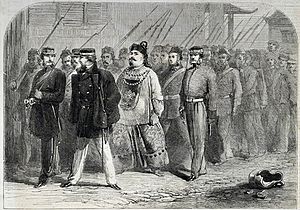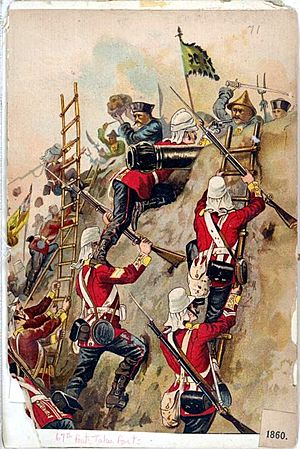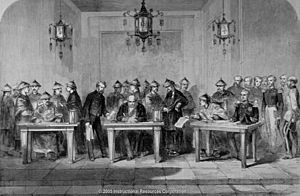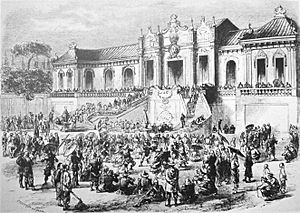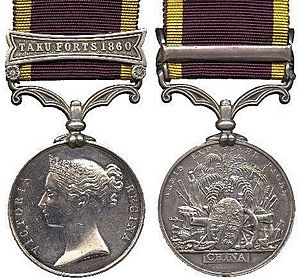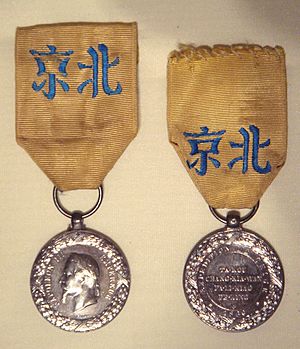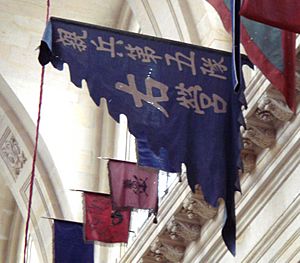Second Opium War facts for kids
Quick facts for kids Second Opium War |
|||||||||
|---|---|---|---|---|---|---|---|---|---|
| Part of the Opium Wars | |||||||||
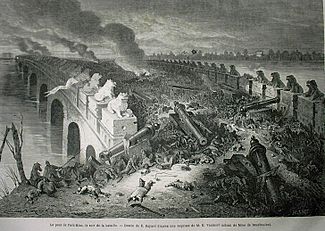 Palikao's bridge, on the evening of the battle of Palikao, by Émile Bayard |
|||||||||
|
|||||||||
| Belligerents | |||||||||
|
|
|||||||||
| Commanders and leaders | |||||||||
|
|
||||||||
| Strength | |||||||||
|
7400 (Eight Banners and Green Standard Army) |
||||||||
| Casualties and losses | |||||||||
|
2900 including
|
|
||||||||
| 1 The U.S. was officially neutral, but later aided the British in the Battle of the Barrier Forts (1856) and the Battle of Taku Forts (1859). | |||||||||
The Second Opium War (also known as the Arrow War) was a big conflict that happened between 1856 and 1860. It involved the United Kingdom and France fighting against the Qing dynasty of China.
This war was the second major part of the Opium Wars. These wars were fought because of disagreements over trade, especially the right to bring a certain product into China. China lost this war, which led to more changes in their trade rules.
In 1860, British and French soldiers went to Beijing. Peace talks failed. The British ordered their troops to loot and destroy the Imperial Summer Palace. This was a huge complex of palaces and gardens where Chinese emperors handled important state business.
During and after the war, China also had to sign agreements with Russia. These agreements, like the Treaty of Aigun and the Convention of Peking, meant China gave up a lot of land to Russia in its northeast and northwest. The war also led to the Kowloon Peninsula becoming part of British Hong Kong. After the war, the Qing government could focus on other problems, like the Taiping Rebellion.
Contents
Why the War Had Different Names
The conflict is called the "Second Opium War" because one of Britain's main goals was to make the trade of a certain product legal in China. China's defeat also meant that British merchants could trade freely across China.
It's also called the "Arrow War." This name comes from a specific event involving a ship called the Arrow, which helped start the fighting.
What Happened Before the War
The Second Opium War followed the First Opium War. After the first war, the Treaty of Nanking was signed in 1842. This treaty gave Britain money, special rights for its citizens in China, and opened five ports for trade. It also gave Hong Kong Island to Britain.
However, Britain wanted even more trade and better diplomatic relations. Because these goals weren't fully met, it led to the Second Opium War. Many Chinese people see the First Opium War as the start of modern Chinese history.
Between the two wars, there were some smaller fights. For example, in 1847, British forces attacked and took forts near Canton (now Guangzhou).
How the War Started
The 1850s was a time when Western countries like Britain and France wanted to expand their influence around the world. They wanted to open new markets for trade and establish more ports.
Britain wanted to change the Treaty of Nanjing from 1842. They asked for all of China to be open to British businesses. They also wanted the trade of a certain product to be legal. Other demands included removing taxes on foreign goods, stopping piracy, and allowing a British ambassador to live in Beijing.
The Arrow Incident
To help Chinese merchant ships, British officials in Hong Kong allowed them to register as British ships. In October 1856, Chinese marines in Canton stopped a ship called the Arrow. They thought it was involved in piracy and arrested twelve Chinese crew members.
The Arrow had been used by pirates before. It was registered as a British ship, but its registration had expired. The ship's captain said he saw Chinese marines pull down the British flag. The British consul in Canton, Harry Parkes, demanded the crew's release and an apology.
The Chinese official, Ye Mingchen, released nine crew members but kept three. This made the British very angry.
First Battle of Canton (1856)
On October 23, the British destroyed four forts. Two days later, they demanded to enter Canton. The next day, the British started firing cannons at the city. Ye Mingchen offered a reward for every British head captured.
On October 29, the British broke through the city walls. British and American flags were placed on the walls. The fighting caused some deaths and injuries. Negotiations failed, and the city was bombed again. On November 6, 23 Chinese war ships were attacked and destroyed. The British returned to Hong Kong in January 1857.
In March 1857, the British government faced a vote in Parliament about the Arrow incident. They lost the vote, which led to a new election in April. The government won more support in this election.
In April, Britain asked the United States and Russia for help, but both countries said no. In May 1857, a serious rebellion started in India. British troops meant for China were sent to India instead.
France Joins the Fight
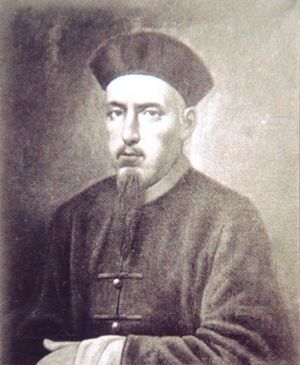
France decided to join Britain against China. This was partly because a French missionary named Auguste Chapdelaine was killed in China. This area was not open to foreigners at the time.
British and French forces teamed up under Admiral Sir Michael Seymour. In late 1857, the British army, led by Lord Elgin, and the French army, led by Jean-Baptiste Louis Gros, attacked and took over Canton. They formed a joint committee to manage the city. They kept the city governor in charge to maintain order. The British-French forces controlled Canton for almost four years.
The combined forces then moved north. They briefly captured the Taku Forts near Tianjin in May 1858.
The US and Russia Get Involved
The United States and Russia sent representatives to Hong Kong. They offered military help to Britain and France. However, Russia did not send any soldiers.
The U.S. was involved in a small conflict during this time. In 1856, Chinese soldiers in Canton fired at a United States Navy ship. The U.S. Navy fired back in the Battle of the Pearl River Forts. They attacked and took the forts near Canton. After this, the U.S. and Chinese governments agreed that the U.S. would stay neutral in the Second Opium War.
Second Battle of Canton (1857)
Throughout 1857, British and French forces gathered in Hong Kong. By December 1857, they had enough ships and soldiers. They demanded that China follow the treaty rules about entering Canton. On December 14, Parkes gave an ultimatum. He threatened to bomb Canton if the remaining crew members of the Arrow were not released within 24 hours.
The remaining Arrow crew members were released. However, Viceroy Ye Mingchen did not apologize or honor the treaty terms. The British and French commanders agreed to attack Canton. This event, the Arrow Incident, gave the war its other name.
Even though the British were busy with the Indian Rebellion of 1857, they attacked Guangzhou from the Pearl River in 1856. Viceroy Ye Mingchen told his soldiers not to fight the British. The British Army took the fort near Canton easily and then attacked the city.
Canton was captured on January 1, 1858. The city had over a million people. Less than 6,000 British and French soldiers captured it. They suffered 15 killed and 113 wounded. Between 200 and 650 Chinese defenders and people in the city were killed or hurt. Ye Mingchen was captured and sent away to India, where he died.
Meanwhile, in Hong Kong, there was a possible attempt to poison the governor, John Bowring, and his family in January. This was known as the Esing Bakery incident.
When news of the Arrow incident reached Britain, it caused a lot of debate. The British House of Commons voted against the government's actions in Canton. In response, Prime Minister Lord Palmerston called for a new election. He won with more support, which silenced those who supported China. The new Parliament decided to demand action from China based on Harry Parkes' report. Britain also asked France, the United States, and Russia to form an alliance.
The Middle Part of the War
Treaties of Tianjin
In June 1858, the first part of the war ended with the four Treaties of Tientsin (Tianjin). Britain, France, Russia, and the U.S. were part of these treaties. They opened 11 more ports in China for Western trade. China first refused to agree to these treaties.
The main points of the treaty were:
- Britain, France, Russia, and the U.S. could have small embassies in Beijing. Beijing was a closed city at the time.
- Ten more Chinese ports would open for foreign trade. These included Niuzhuang, Tamsui, Hankou, and Nanjing.
- All foreign ships, including trade ships, could travel freely on the Yangtze River.
- Foreigners could travel inside China, which was not allowed before.
- China had to pay a large amount of silver to Britain and France.
Treaty of Aigun
On May 28, 1858, a separate agreement, the Treaty of Aigun, was signed with Russia. This changed the border between China and Russia. Russia gained land along the Amur River. A later agreement in 1860, the Convention of Peking, gave Russia control over a warm-water port on the Pacific coast. Russia founded the city of Vladivostok there in 1860.
The Second Phase (1858–1860)
Battles at Taku Forts
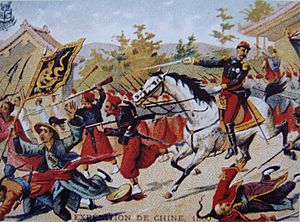
On May 20, the British won the First Battle of Taku Forts. But the peace treaty gave the forts back to the Chinese army.
In June 1858, after China agreed to the treaties, some Chinese officials convinced the Xianfeng Emperor to fight back. On June 2, 1858, the Emperor ordered General Sengge Rinchen to guard the Taku Forts near Tianjin. Sengge Rinchen added more cannons and brought 4,000 Mongol cavalry soldiers.
The Second Battle of Taku Forts happened in June 1859. A British naval force with 2,200 soldiers and 21 ships sailed north. They wanted to go to Beijing. They reached the mouth of the Hai River, guarded by the Taku Forts. Sengge Rinchen said the British and French representatives could land further up the coast and go to Beijing, but without armed troops. The British and French insisted on landing at Taku with their soldiers.
On June 24, 1859, a small group of British forces blew up barriers in the river. The next day, British forces tried to sail into the river and fired at the Taku Forts. But the tide was low, and the mud stopped them from landing. Sengge Rinchen's cannons were very accurate. They sank four British gunboats and badly damaged two others. An American Commodore, Josiah Tattnall III, helped the British retreat, saying "blood is thicker than water". Losing at Taku Forts was a big blow to British pride.
After the rebellion in India was put down, Sir Colin Campbell prepared for another attack in China. He made sure the British forces had plenty of supplies. This helped keep casualties low.
The Third Battle of Taku Forts happened in the summer of 1860. Lord Elgin returned with British and French forces. There were 11,000 British troops and 6,700 French troops. They sailed north from Hong Kong with 173 ships. They captured the port cities of Yantai and Dalian. On August 3, they landed near Beitang, close to the Taku Forts. They captured the forts on August 21 after three weeks of fighting.
Chinese laborers also helped the French and British forces. They carried ladders and helped the soldiers cross ditches during the attack on the forts. They were brave under fire and wanted to fight their own countrymen.
Burning of the Summer Palaces
After taking Tianjin on August 23, 1860, the British kidnapped the prefect of Tianjin. In return, Parkes and other British and French officers, Sikh soldiers, and a journalist were arrested on September 18. They were imprisoned and questioned.
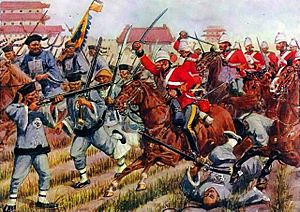
British and French forces fought Sengge Rinchen's Mongol cavalry on September 18 at the Battle of Zhangjiawan. Then they moved towards Beijing for a big battle in Tongzhou. On September 21, at Baliqiao (Eight Mile Bridge), Sengge Rinchen's 10,000 troops, including his best Mongol cavalry, were destroyed. They charged directly into the strong firepower of the British and French forces. The French army reached the Summer Palace outside Beijing on October 6, and the British arrived a day later.
With the Chinese army defeated, the Xianfeng Emperor fled the capital. He left his brother, Prince Gong, to handle peace talks. The Emperor first went to the Chengde Summer Palace and then to Rehe Province. British and French troops immediately started looting the Summer Palace (Yiheyuan) and Old Summer Palace (Yuanmingyuan). These palaces were full of valuable artwork.
After Parkes and the other prisoners were released on October 8, it became clear how badly they had been treated. Lord Elgin suggested destroying the Forbidden City to punish China. This would also get revenge for the mistreatment of the prisoners. However, attacking Beijing was ruled out. Elgin decided to burn the Summer Palace instead. He explained that this punishment would affect only the Emperor, who was directly responsible.
On October 18, British soldiers burned the Summer Palace. The French refused to help. It took two days to burn the buildings. Other imperial properties nearby were also destroyed.
Awards for Soldiers
Both Britain and France gave out medals for the campaign. The British medal had different bars for specific battles, like "Taku Forts 1860" and "Peking 1860."
What Happened After the War
On October 24, Prince Gong, the emperor's brother, agreed to the demands of the British and French. The emperor had already fled Beijing on September 22. British and French troops entered Beijing. There, the Treaty of Tientsin was officially approved by the Convention of Peking.
At that time, the largest encyclopedia in the world was the 1408 Ming Dynasty Yongle Encyclopedia. Most of it was looted or destroyed by foreign soldiers during the attack on Beijing. Only about 3.5 percent of the volumes still exist today.
The British, French, and Russians were allowed to have permanent diplomatic offices in Beijing. This was something China had resisted because it suggested that China and European powers were equal. China also had to pay a large amount of silver to Britain and France. Kowloon was given to British Hong Kong. The trade of a certain product was made legal. Christians were given full rights, including the right to own property and to spread their faith.
The Convention of Beijing included:
- China officially agreeing to the Treaty of Tianjin.
- Opening Tianjin as a port for trade.
- Giving part of Kowloon to Britain.
- Allowing freedom of religion in China.
- British ships could carry Chinese workers to the Americas.
- China had to pay even more silver to Britain and France.
- The trade of a certain product was made legal.
Two weeks later, Russia made China sign another treaty. This treaty gave Russia more land east of the Ussuri River. This land became part of Russian Manchuria. Russia then founded the port of Vladivostok there.
The British press celebrated the British and French victory. This made British Prime Minister Lord Palmerston very popular. British merchants were happy about the chance for more trade in Asia. Other foreign countries were also pleased, hoping to benefit from China opening up.
The defeat of the Chinese army by a much smaller British and French force was a huge shock to the powerful Qing Empire. The emperor fled, and the Summer Palace was burned. This was a great humiliation for China. After the war, China started a big effort to modernize itself. This was called the Self-Strengthening Movement. They also began several important changes to their government and society.
The trade of a certain product was strongly opposed by William Ewart Gladstone, who later became a British Prime Minister. He called it "most infamous and atrocious." Gladstone was against both Opium Wars. He strongly opposed the British trade of this product to China. He also spoke out against British violence towards the Chinese. Gladstone called it "Palmerston's Opium War." He said he feared "the judgments of God upon England for our national iniquity towards China."
Seven Victoria Cross awards were given for bravery. These were for soldiers who fought on August 21, 1860, at the Battle of Taku Forts (1860).
Images for kids
-
The Illustrated London News print of the clipper steamship Ly-ee-moon, built for the opium trade, c. 1859
See also
 In Spanish: Segunda guerra del Opio para niños
In Spanish: Segunda guerra del Opio para niños
- China–United Kingdom relations
- Imperialism in Asia
- Nian Rebellion
- Miao Rebellion (1854–73)
- Dungan Revolt (1862–77)
- Panthay Rebellion
- History of Beijing
- Taiping Rebellion


